What’s the diagnosis?
A 6-month-old boy with an oedematous and purpuric eruption
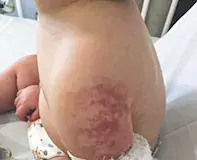
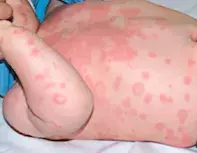
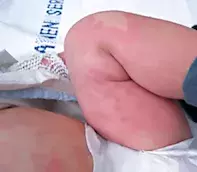
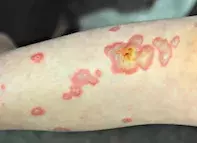
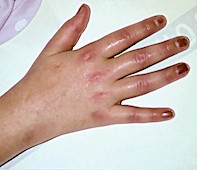
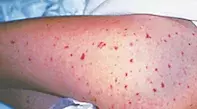
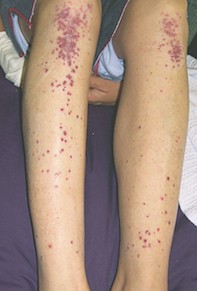
Case presentation
A 6-month-old boy presents to the hospital accident and emergency department with sudden onset of a rash on his trunk and arms (Figure 1). He has had a viral respiratory tract infection for two days. His two older siblings are well.
On examination the boy has multiple swellings with nonblanching overlying purpuric discolouration. His hands and feet are swollen. There are no mucosal lesions and he is afebrile and happy.
Differential diagnoses
Conditions to consider among the differential diagnoses for a child of this age include the following.
- Urticaria. Urticaria in small children is most often associated with viral illnesses. The typical lesion is raised, skin-coloured to pink, evanescent and migratory (Figure 2). Urticaria may at times appear purple in small children (Figure 3); however, the colour is much less intense than in this case and typically the lesions move continuously.
- Erythema multiforme. In children, erythema multiforme is usually precipitated by herpes simplex virus or Mycoplasma pneumoniae infection. It consists of multiple target lesions that do not migrate and that have a vesicular centre (Figure 4). Mucosal involvement is very common although not invariable. Lesions are not urticarial but may appear purpuric.
- Kawasaki disease. A febrile illness with systemic vasculitis that typically affects children aged 3 to 6 years, Kawasaki disease can occur in the first year of life. Patients are unwell and persistently febrile for five days or more.1 This is associated with conjunctival injection, red and cracked lips, a rash and erythema and swelling of the hands and feet (Figure 5). The rash is polymorphic, taking many forms and can be urticarial. It is important to recognise Kawasaki disease and to treat it early with intravenous gammaglobulin to prevent coronary complications.
- Meningococcal disease. Patients with meningococcal disease may be deceptively well at first. More commonly, however, patients are febrile and unwell with signs of meningism. The rash itself is vasculitic with typical palpable purpura, which is more common on the lower limbs than the trunk (Figure 6). It is not urticarial.
- IgA vasculitis (Henoch-Schönlein purpura). This immune-complex vasculitis occurs in children, usually between 4 and 6 years of age, and affects the skin, gut and joints. IgA immune deposits are found in small vessels,2 and glomerulonephritis identical to IgA nephropathy can occur. Patients present with a purpuric rash (Figure 7), arthralgia and abdominal pain. Urticaria, vesicles, bullae and necrotic ulcers may occur. The rash distribution is usually the lower limbs and buttocks but any part of the skin may be involved.
- Acute haemorrhagic oedema of infancy. This is the correct diagnosis. Although alarming in appearance, it is a benign condition.3,4 Patients are typically aged between 4 months and 2 years. The lesions are both urticarial and purpuric with a targetoid appearance. There may be facial, earlobe and eyelid oedema. Histopathology shows a leucocytoclastic vasculitis, sometimes with IgA deposits. In many cases there is a trigger – a respiratory infection, medication or rarely vaccination – but about 25% of cases are idiopathic.5 The child is well, with no arthritis or abdominal pain and there is no renal involvement. Spontaneous recovery occurs within three weeks and recurrences do not occur.6
Outcome
For the case patient, urine testing was performed for protein, red blood cells and casts; normal results were returned. Reassurance was provided to the parents and the baby was discharged.
References
1. McCrindle BW, Rowley AH, Newburger JW, et al. Diagnosis, treatment, and long-term management of Kawasaki disease: a scientific statement for health professionals from the American Heart Association. Circulation 2017; 135: e927-e999.
2. Hočevar A, Rotar Z, Jurčić V, et al. IgA vasculitis in adults: the performance of the EULAR/PRINTO/PRES classification criteria in adults. Arthritis Res Ther 2016; 18: 58.
3. Pittet LF, Siebert JN, Lacroix LE. Striking but benign: acute haemorrhagic oedema of infancy. Lancet 2015. pii: S0140-6736(15)00318-9.
4. Haeusler IL, Mohan R. Acute haemorrhagic oedema of infancy: a benign cause of a formidable rash. BMJ Case Rep 2018; 2018. pii: bcr-2017-223368.
5. Carvalho C, Januário G, Maia P. Acute haemorrhagic oedema of infancy. BMJ Case Rep 2013; 2013. pii: bcr-2012-008145.
6. Liu AJW, Hogan P, Nanan R. Acute haemorrhagic oedema of infancy. Arch Dis Child 2006; 91: 382.
Child development

